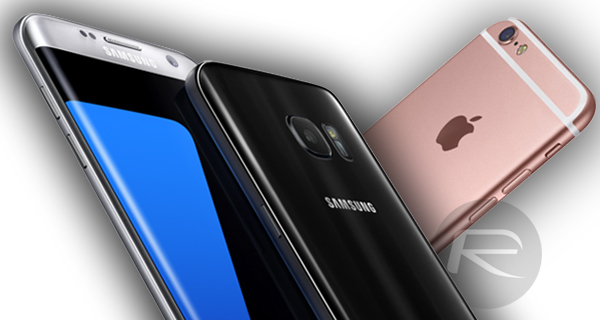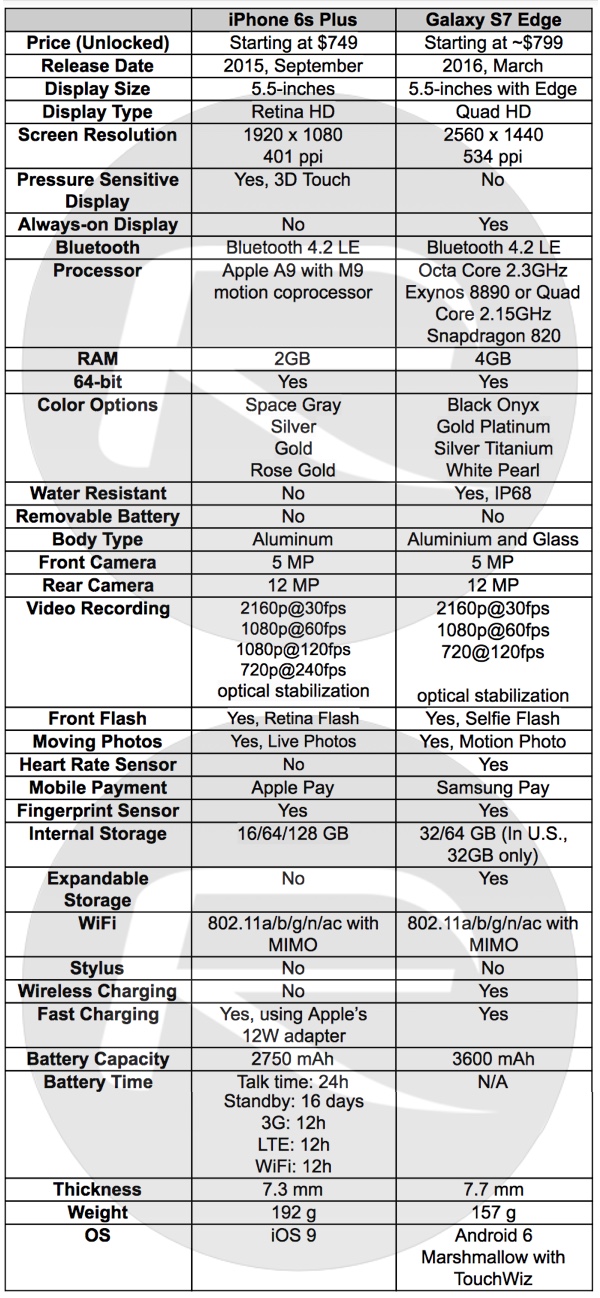Choosing which smartphone to purchase and run with for the next 12/24 months is not as much of an easy choice as it once used to be. Companies are continually pushing the boundaries of what’s possible with mobile technology, which inadvertently makes it a lot more difficult when it comes to choice. Samsung and Apple are pioneers of that push, a focus that has resulted in the availability of the iPhone 6s and iPhone 6s Plus since September 2015, as well as the Galaxy S7 and Galaxy S7 Edge which made their debut at MWC 2016. But how do these devices compare in terms of technical specification when thrust together in a side-by-side comparison?
The iPhone 6s Plus and Galaxy S7 Edge are both flagship devices that are bordering on finding themselves in the “phablet” category of hardware. Both ship with 5.5-inch displays. On the other hand we have the smaller devices from the company for those who are not really a fan of larger phones, with Apple choosing to go with 4.7-inch display in iPhone 6s compared to Samsung going in with 5.1-inch display in the standard non-edge version of Galaxy S7.

On paper though, you’d be forgiven for thinking that the Galaxy S7 and S7 Edge blows the iPhone 6s and 6s Plus away based on specifications alone, but there’s always more than that to consider. There’s the fact that Apple’s hardware and software have been optimized to perform seamlessly with one another, with the Cupertino-based company extracting every last ounce of performance out of that marriage. We’ve all seen how effective that is a number of times in the past.
In the table below, you can check out the full technical specifications and compare every aspect of Apple’s and Samsung’s current flagship devices.
Samsung Galaxy S7 / S7 Edge Vs Apple iPhone 6s / 6s Plus:
 Samsung Galaxy S7 vs Apple iPhone 6s
Samsung Galaxy S7 vs Apple iPhone 6s
 Samsung Galaxy S7 Edge vs Apple iPhone 6s Plus
Samsung Galaxy S7 Edge vs Apple iPhone 6s Plus
Samsung Galaxy S7 / S7 Edge feature highlights:
- Android Marshmallow.
- Quad HD always-on display, edge screen with Edge model.
- Expandable storage.
- Built-in heart rate sensor.
- Larger battery with Qi wireless charging support.
- IP68 Waterproof.
Apple iPhone 6s / 6s Plus feature highlights:
- iOS 9
- Pressure sensitive display called 3D Touch.
- Has 128GB internal flash storage option.
- Slo-Mo mode in 1080p resolution.
- Thinner.
- Lighter*
As mentioned earlier, while Samsung’s 2016 flagship lineup looks very good on paper, it really doesn’t tell the full story. We will have to wait for benchmarks and real-world performance tests to truly see which one of these devices come out on top.
For now though, the real important thing to remember here is that no matter which manufacturer or model you ultimately choose to go with, chances are that you aren’t going to be disappointed. There’s a real reason why Apple and Samsung find themselves consistently at the top of the smartphone hierarchy, and that reason is because both companies continually pump out excellent hardware.
A lot of the time, it really comes down to one question; would you prefer iOS or Android? But here in both cases, you can’t really go wrong with any of these devices.
So, out of these four smartphones, which one would you rather pick? Share your thoughts with us in the comments section below.
Update x1: We now have waterproof test between Galaxy S7 and iPhone 6s Plus:
Update x2: Drop test:
Update x3: Real-world speed test:
Update x4: Here are two more videos showing side-by-side real-world speed test comparison between both Exynos and Snapdragon Galaxy S7 Edge vs iPhone 6s Plus:
Snapdragon Galaxy S7 Edge vs iPhone 6s Plus
Exynos Galaxy S7 Edge vs iPhone 6s Plus
*While the iPhone 6s is lighter than both Galaxy S7 and S7 Edge, the larger iPhone 6s Plus is significantly heavier than both S7 and S7 Edge.
You may also like to check out:
- Galaxy S7 / S7 Edge Official: Specs, Price, Release Date
- Samsung Galaxy S7 / S7 Edge Vs Galaxy S6 / S6 Edge Comparison: Should You Upgrade?
- Top 8 Reasons Why Galaxy S7 Is Better Than iPhone 6s And Vice Versa
You can follow us on Twitter, add us to your circle on Google+ or like our Facebook page to keep yourself updated on all the latest from Microsoft, Google, Apple and the Web.

